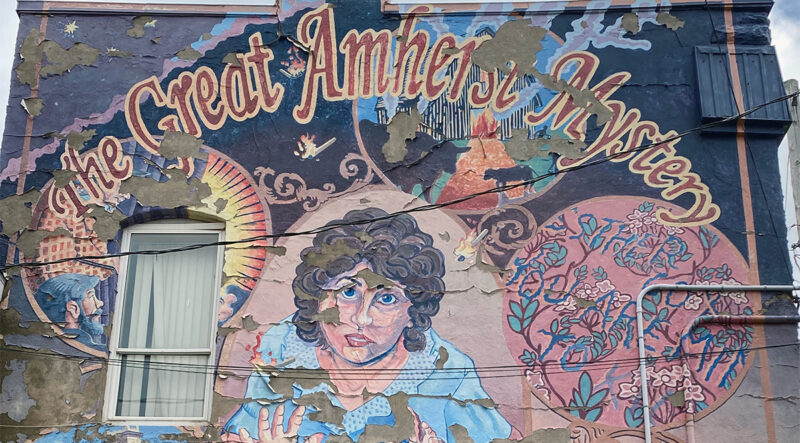A small town 10 km southeast of the New Brunswick-Nova Scotia border celebrates its haunted history much like Salem, Massachusetts.
Amherst, Nova Scotia’s story, however, does not involve a witch hunt. It involves a poltergeist and the well-being of an 18-year-old woman.
In the fall of 1878, 18-year-old Esther Cox, and her younger sister Jennie, started to hear strange knocking in the middle of the night. The two lived with their brother, sister Nelly, elder sister, Olive Teed, her husband Daniel as well as their two children.
The rapping eventually increased in ferocity, leading to knockings and objects being thrown about the room. Cox began suffering seizures, fevers, and chills as well as visible swelling of her body.
The Teeds contacted the doctor who witnessed the poltergeist activity. Scratching was heard and the words, “Esther Cox, you are mine to kill” appeared on the wall above her bed. The phenomena continued for 15 months.
It also attracted the attention of American actor Walter Hubbell, who visited the town to investigate the phenomenon (with the intention of debunking it) but wrote about it instead in his book The Great Amherst Mystery. He posited that the poltergeist activity began after an alleged sexual assault. Cox had been on a carriage ride into the Tantramar Marsh with her beau Bob MacNeill.
Hubbell’s book provided the inspiration for Charlie Rhindress’ stage adaptation Guilty! The Story of the Great Amherst Mystery in 1991. When Rhindress returned to his hometown in 2016, he approached the town about putting the play on as part of an annual homage to the local ghost story.
“They were interested in the idea of capitalizing on the story of the Great Amherst Mystery,” he recalled, during a September Zoom conversation. “If this was the United States, there already would’ve been a movie about it, a TV show and there’d be a museum.
“If you look at Salem or even Amityville, they become known for these things.”
Rhindress was hired on as a consultant and spent the next six months in public meetings, visiting some of the more well-known dark tourism locations like Salem, Massachusetts to flush out ideas for an annual festival.
What came from his groundwork were three suggestions: the town could work with community groups to put on an event; they could invest a fair amount of money into it to make it a larger festival, or they could have a nonprofit organization with a committee take over and raise funds by collaborating with Canadian Heritage and the Arts Nova Scotia.
Thus, Esther Fest — a celebration of the paranormal inspired by Esther Cox’s story.
Laurie Glenn Norris wrote about the life of Esther Cox before and after the events of 1878 in her book Haunted Girl: Esther Cox and the Great Amherst Mystery. Norris, with Barbara Thompson, deconstructed Cox’s life, and suggested, given the experiences she had as a child, that Cox struggled with mental health.
There was a sense of insecurity within her home life, with the death of her mother during childbirth, and her father remarrying, only to have another wife die. He would marry a third time and move to Maine.
Eventually, the children would be split up, and raised with different members of the family. When the family reunited, under the Teed house there would be eight people, and Esther was tethered to the housework, while everyone else was busy.
“Esther just seems to be at the bottom of the barrel,” Norris said, during the same Zoom call, adding that spiritualism was also present within the Teed household before the events of 1878.
The mystery surrounding what happened between Esther Cox and Bob MacNeill would be all that was needed to trigger Cox, Norris suggested.
“She’s got her dream fulfilled (with Bob),” Norris said. “But something happened that night. Hubbell says that Bob pulled a gun on her. Now that might be a euphemism for something else, but we don’t know what happened there.”
The final detail of the story is the added element of spiritualism. The spiritual movement that sparked interest in communicating with the dead reached its peak from the 1840s to the 1940s.
“Walter Hubbell does mention that when he first lands in Amherst, Esther and the rest of the family are doing seances and mesmerism was involved,” Norris said. “So, this type of thing was in the air.”
The march of time has seen the house removed from the Amherst landscape. Street numbers have also changed since the events of 1878, so the exact location of the Teed House is not known.
“It’s just a tiny little street. It’s like one block long, and we don’t know exactly where the house was,” Rhindress said. “If I could find records from the 1870s, maybe we could.”
Even though the house no longer remains, the community still talks about it. Rumours and myths arise, and even superstitions happen.
For 2023, some of the events taking place are a reading of Rhindress’ play, a performance from Live Bait Theatre called, Shivers: 3 Tales of Supernatural Tantramar, a ghost hunt with local investigators Parasight, as well as a modest paranormal conference with Norris, Rhindress, Paranormal Phenomena Research and Investigation lead Elliott van Dusen and parapsychologist Darryll Walsh taking part.
“There will always be interest in Esther,” Norris admitted.
Esther Fest runs from October 17 to October 30.

